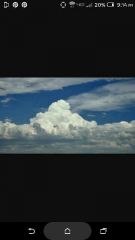![]()
![]()
![]()
Use LEFT and RIGHT arrow keys to navigate between flashcards;
Use UP and DOWN arrow keys to flip the card;
H to show hint;
A reads text to speech;
137 Cards in this Set
- Front
- Back
- 3rd side (hint)
|
Why is it colder in the winter and warmer in the summer? |
Because of the tilt of the earth's axis and angle of the sun's rays (the earth is at a 23.5° vertical tilt) |
|
|
|
What determines the amount of solar energy (insulation) that reaches the earth surface? |
It is dependent on how the angle of the sun's rays strike the Earth |
|
|
|
Where is more heat delivered by insulation? |
Where the sun is directly overhead |
|
|
|
Where is the total annual insulation the least? Where is it the most? |
Least at the poles most at the equator |
|
|
|
On The first day of summer in the northern hemisphere where is the sun directly overhead? |
At the tropics of cancer (23.5°n) |
|
|
|
On the first day of Winter in the Northern hemisphere where is the sun directly overhead? |
The tropics of Capricorn (23.5°s) |
|
|
|
At the start of spring and fall in the northern hemisphere where is the sun directly overhead? |
At the Equator (0°) |
|
|
|
What is the official start to spring called? |
Spring Equinox (vernal) |
|
|
|
What is the official start of fall called? |
Fall equinox (autumnal) |
|
|
|
High latitudes have _______ daylight than low latitudes in summer and _____ in the winter. |
More daylight in the summer and less in the winter |
|
|
|
How do you calculate the sun angle? |
90- the zenith angle = the sun angle |
Zenith = the difference in two latitudes -Subtract if locations are in the same hemisphere +add if locations are in different hemispheres |
|
|
________ is localized atmospheric conditions over a short period of time and is constantly changing. |
Weather |
|
|
|
______ Is a regional area that experiences atmospheric conditions over a longer period of time. |
Climate |
|
|
|
*Air is a mixture of discrete gases* What are the major components of clean, dry air? (And what are the percentages?) |
Nitrogen (78%) Oxygen (21%) Carbon dioxide (0.0040%) Argon and other gasses
|
There are 4 |
|
|
What does the carbon dioxide in clean air do for the earth? |
Absorbs heat energy from the earth |
|
|
|
What are the variable components of air? |
Water vapor (water as gas) Ozone |
There are 2 |
|
|
Describe the variable component of air "water vapor" |
It is water as gas It forms clouds and precipitation It absorbs heat energy from earth along with carbon dioxide |
|
|
|
Describe the component of air "ozone" |
-three atoms of oxygen -concentrated higher in our atmosphere Absorbs harmful ultra violent radiation (serves as a natural filter) |
|
|
|
________ is the measure of the average molecular motion (kinetic energy) |
Temperature |
|
|
|
What is the average sea level pressure? |
1013 millibars (about 14.7 lbs per square inch) |
|
|
|
_______ is the weight of the air above |
Pressure |
|
|
|
Does pressure increase or decrease with altitude? |
Decreases |
|
|
|
One half of the atmosphere is below ____ miles |
3.5 miles |
|
|
|
What are the atmospheric levels from lowest to highest? |
Troposphere Stratosphere Mesophere Thermosphere |
|
|
|
Describe the troposphere What layer is it? |
*The bottom layer *Considered the "zone of weather" *The temperature decreases with altitude called the environmental lapse rate (3.5°F per 1,000feet) *The average height is 7.5 miles |
|
|
|
Describe the stratosphere What layer is it? |
*The second layer *temperature increased at top- (caused by the ozone ) |
|
|
|
Describe the mesophere What layer is it? |
*the third layer * temperature decreases *region where meteors occur |
|
|
|
Describe the Thermosphere What is the layer? |
*The fourth and highest layer *no well defined upper limit *small % of atmospheres mass *gasses moving at high speeds= higher temperature |
|
|
|
Heat is always transferred from _______ to _________ objects |
Warmer to cooler |
|
|
|
What are the mechanisms of heat transfer? |
*conduction *convection *radiation |
There are three |
|
|
*mechanisms of heat transfer* Describe conduction |
Transfer through a solid |
|
|
|
*mechanisms of heat transfer* Describe convection |
*mass movement of molecules within a substance (liquid or gasses) - reason for daily temperature variations |
|
|
|
*mechanisms of heat transfer* Describe radiation |
Transfer by electromagnetic waves |
|
|
|
What is the only substance that exists in all three states on earth? |
Water |
|
|
|
Water is constantly cycled through the ________ |
Atmosphere |
|
|
|
Conversion of water from one state to another transfers energy throughout the _________ |
Troposphere |
|
|
|
How is heat energy Measured |
By calories |
|
|
|
How many calories does it take to make the heat necessary to raise the temperature one gram of water 1°C |
1 calorie |
|
|
|
_________ is stored or hidden heat and is not derived from temperature change |
Latent heat |
|
|
|
Going from Solid ice to gas (water vapor) is called |
Sublimination |
|
|
|
_______ is the process of Going from solid ice to to liquid (water) and _______ is the process of going from liquid (water) to gas (water vapor) |
Melting ; evaporation |
|
|
|
______ is the process of going from gas(water vapor) to liquid (water). And ______ is the process of liquid (water) turning to solid ice. |
Condensation ; freezing |
|
|
|
Going directly from a gas(water vapor) and solid Ice is called? |
Deposition |
|
|
|
Does sublimination absorb or release heat? What about deposition? |
Sublimination absorbs Deposition releases |
|
|
|
________ is the amount of water vapor in the air |
Humidity |
|
|
|
_________ is air that is filled with water vapor to capacity |
Saturated air |
|
|
|
________ is temperature dependent |
Capacity ; warm air has a greater capacity |
|
|
|
Water vapor adds _____ (called ___________) to the air |
Pressure (called vapor pressure) |
|
|
|
How do you figure out the relative humidity? |
RH= WATER VAPOR CONTENT/WATER VAPOR CAPACITY (X100) =_____% |
|
|
|
As temperature goes _____ the capacity is going _____ which means relative humidity is going _____ |
Up ; up ; down |
|
|
|
What two ways can relative humidity be changed |
* add/subtract moisture to the air *changing the air temperature |
|
|
|
________ is the temperature to which a parcel of air would need to be cooled to reach __________ |
Relative humidity ; saturation RH= 100% |
|
|
|
Cooling the air below the dew point causes _________ |
Condensation |
|
|
|
______ is an instrument used to measure relative humidity |
Hygrometer |
|
|
|
_________________ is used to compare temperatures of a wet bulb thermometer and a dry bulb thermometer |
Sling psychrometer |
|
|
|
______________ reads the humidity directly by the expansion/contraction of hair |
Hair Hygrometer |
|
|
|
_____________ measures electrical current (influenced by water vapor) |
Electrical Hygrometer |
|
|
|
What happens when air is compressed? |
*the motion of air molecules increases *air will warm **descending air is comprised due To encreasing air pressure** |
|
|
|
What are the processes that lift air? |
*Orographic lifting *frontal wedging *convergence *localized convective lifting |
There are 4 |
|
|
*processes that lift air* Describe Orographic lifting |
*elevated terrains act as barriers |
|
|
|
*processes that lift air* Describe frontal wedging |
*cool air acts as a barrier to warm air *fronts are part of the storm system called middle latitude cyclones |
|
|
|
the air is flowing together and rising (low pressure)what are these characteristics describing? |
*processes that lift air* Convergence |
|
|
|
Occurs where unequal surface heating causes pockets of air to rise because of their buoyancy Are characteristics of? |
*processes that lift air*Describe localized convective lifting |
|
|
|
What are clouds composed of? |
Tiny water droplets, or small crystals of ice |
|
|

What cloud is high, white and thin |
Cirrus clouds |
|
|

What type of cloud is globular cloud masses that is often associated with fair weather (cotton ball) |
Cumulus clouds (They are flat on the bottom due to the dew point) |
|
|

What type of cloud looks like sheets or layers that cover much of the sky? |
Stratus clouds |
|
|
|
What types of clouds are considered to be high clouds? |
Cirrus, cirrocumulus and cirrostratus clouds |
|
|

What type of cloud is this? |
Cirrostratus clouds |
|
|

What type of cloud is this ? |
Cirrocumulus |
|
|
|
What types of clouds are considered to be middle clouds? |
Altostratus and altocumulus |
|
|

What type of cloud is this? |
Altocumulus |
|
|

What type of cloud is this? |
Altostratus |
|
|
|
What types of clouds are considered low clouds? |
Stratus, Stratocumulus and nimbostratus |
|
|

What type of cloud is this? |
Stratocumulus |
|
|

What type of cloud is this? |
Nimbostratus |
|
|
|
Clouds of vertical development that forms low to high altitudes and often produces rain showers and thunderstorms is called? |
Cumulonimbus |
|
|
|
______is a cloud with its base at or near the ground and is considered an atmospheric hazard |
Fog |
|
|
|
Most fog forms because of _______ or _______ |
Radiation cooling or movement of air over a cold surface |
|
|
|
What are the four types of fog |
*Advection fog *radiation fog *upslope fog *steam fog |
|
|
|
What type of fog happens when warm, moist air moves over a cool surface (such as along the coast) |
Advection fog |
|
|
|
What type of fog happens when the earth's surface cools rapidly (forms during cool, clear, calm nights ) |
Radiation fog |
|
|
|
What type of fog happens when humid air moves up a slope (such as in the tropics) and adiabatic cooling occurs |
Upslope fog |
|
|
|
What type of fog happens when cool air moves over warm water and moisture is added to the air |
Steam fog |
Water has a steaming effect |
|
|
What is precipitation? |
Cloud droplets that are less than 20 micrometers (0.02 millimeters in diameter) and fall incredibly slowly |
|
|
|
What is the formation of participation? |
It is a complex process that involves both ice crystals and collision of water droplets |
|
|
|
What are the forms of precipitation? |
Rain, drizzle, snow, sleet, glaze, and hail |
There are 6 of them |
|
|
What form of precipitation has droplets that are at least 0.5mm in diameter? |
Rain |
|
|
|
What form of precipitation has droplets less than 0.5mm in diameter |
Drizzle |
|
|
|
What form of precipitation is ice crystals, or aggregates of ice crystals? |
Snow |
|
|
|
What form of precipitation is rain that freezes while falling and occurs when warmer air overlies colder air? |
Sleet |
|
|
|
What form of precipitation has impact with a solid that causes freezing (rain that freezes on contact) |
Glaze or freezing rain |
|
|
|
What form of precipitation is made up of hard round pellets and concentric shells (most diameters range from 1 to 5cm |
Hail |
|
|
|
How is hail formed? |
Formation occurs in large cumulonimbus clouds with violent up and down drafts layers of freezing rain are caught in up and down drafts |
|
|
|
______________ is the force exerted by the weight of the air above, the weight of the air at sea level, and decreases with altitude |
Atmospheric pressure |
|
|
|
Slandered sea level pressure is ______ inches of mercury |
29.92 |
|
|
|
The ________ or ___________ was invented by ___________ in 1643 and uses a glass tube filled with mercury to measure pressure |
Barometer, mercury barometer, Torricelli |
|
|
|
The ___________ measures atmospheric pressure without liquid and uses an expanding chamber |
Anroid barometer |
|
|
|
________ continuously records the air pressure (has the advantage of being continuous and portable) |
Barograph |
|
|
|
Horizontal movement of air moves out of areas of _____ pressure and into areas of ______ pressure |
High, low |
|
|
|
What are the controls of wind? |
1) pressure gradient force (off) 2) Coriolis effect 3) friction |
There are three |
|
|
What are the characteristics of pressure gradient force |
Uses isobars- lines of equal air pressure Pressure gradient- pressure changes over distance |
|
|
|
Describe the Coriolis effect |
Apparent deflection (curving) in the wind direction due to the earth's rotation *(deflection is due to to the right in the northern hemisphere and left in the southern hemisphere)* |
|
|
|
Describe friction |
Only important near the surface, and acts to slow the airs movement |
|
|
|
Describe upper air winds |
(No friction) generally blow parallel to isobars called geographic winds (east to west) |
|
|
|
______ are high altitudes or "rivers" of air, have a velocity of 70-140 mph, and determines the track of storms |
Jet streams |
|
|
|
What is a cyclone |
*The L on a weather map * it is a center of low pressure *pressure decreases towards the center |
|
|
|
What are the winds associated with a cyclone in the northern hemisphere? In the southern hemisphere? |
**Northern hemisphere Winds move inward (convergence) In a counterclockwise direction **southern hemisphere Winds move inward (convergence) In a clockwise direction |
|
|
|
______ is associated with rising air and often bring clouds and precipitation |
Cyclone |
|
|
|
What is an anticyclone |
*the H on a weather map *a center of high pressure *pressure increases towards the center |
|
|
|
What are the winds associated with an anticyclone in the northern hemisphere? In the southern hemisphere? |
**in the northern hemisphere Winds move outwards (divergence) And clockwise **in southern hemisphere Winds move outwards (divergence) And counterclockwise |
|
|
|
What is the underlying cause of general atmospheric circulation |
Unequal surface heating |
|
|
|
On the rotating earth there are three pairs of _________ that redistribute the heat |
Atmospheric cells |
|
|
|
What are the idealized global circulations? |
*equatorial low** pressure zone (0°) *subtropical high** pressure zone (30°) *subpolar low** pressure zone (60°) * polar high** pressure zone (90°) |
There are 4 |
|
|
Rising air and abundant precipitation are the characteristics of? |
equatorial low pressure zone (0°) |
|
|
|
Subsiding, stable, dry airMajority of the world's desserts are found here are the characteristics of what? |
the subtropical high pressure zone (30°) |
|
|
|
What are the characteristic s of subpolar low pressure zone (60°) |
Warm and cool air interact at 60° The polar front is an area of storms |
|
|
|
Cold, subsiding air at ___°Air spreads towards the equator are the characteristics of what? |
the polar high pressure zone (90°) |
|
|
|
______ is a seasonal shift that causes substantial change in wind direction, occur over continents |
Monsoon |
|
|
|
________ is produced from temperature differences, has small scale winds |
Local winds |
|
|
|
What are the types of local winds |
Land and sea breezes Mountain and valley breezes **all local winds are set up by localized pressure gradients (temperature differences)** |
|
|
|
What are the two basic measurements of wind? |
Direction and speed |
|
|
|
How is the direction of wind measured? |
Winds are labeled from where they originate **(north winds blow from north towards the south)** |
|
|
|
What is the instrument used for measuring wind direction called? |
The windvane |
|
|
|
What is wind speed often measured with? |
Cup anemometer |
|
|
|
______ now refers to the large cavalry reversal of the normal currents in the pacific ocean |
El niño |
was originally named for a warm counter current that flows South along the coast of Ecuador and Peru *often appeared during the Christmas season* |
|
|
-large body of air (1000 miles or more across, perhaps several miles thick) -similar temperature and moisture characteristics -move and affect a large portion of a continent These are all characteristics of what? |
Air masses |
|
|
|
__________ of air masses is the region where an air mass acquires it's properties |
Source region |
|
|
|
What are the two criteria used to classify Air masses |
*By the altitude of the source region (Polar, and Tropical) *By the nature of the surface in the source region (over land and water) (Continental, and maritime) |
|
|
|
Describe Polar (P) |
High latitudes Cold |
|
|
|
Describe tropical (T) |
Low latitudes, and warm |
|
|
|
Describe continental (C) |
Form over land , and likely to be dry |
|
|
|
Describe maritime (M) |
Form over water and is humid |
|
|
|
What are the four basic types of air masses |
Continental polar (cP) Continental tropical (cT) Maritime polar (mP) Maritime tropical (mT) |
|
|
|
What are the types of fronts? |
Cold fronts Warm fronts Occluded fronts Saturated fronts |
|
|
|
*Warm air replaces cooler air *shown on a map by a red line semicircle *low slope angle (boundary) *slow rate of movement *light to moderate precipitation arrives well ahead of the warm air *Moves South to southwest These are all characteristics of what? |
Warm front |
|
|
|
*cold air replaces warm air *twice as steep as warm fronts *associated weather is more intense than a warm front (intensity of precipitation is greater but duration is shorter) *advances faster than a warm front Passage is marked by drop/rise in temperature and winds shift from south, South west to north, north west
These are all characteristics of?
|
A cold front |
|

